How to get cost usage of your S3 buckets using Terraform, Lambda, Glue and Athena
If your are working with AWS and you have multiple buckets and files, and your infrastructure is fast growing, it will start to be hard to find a way to get information and cost for all your bucket as S3 can be very costly if it’s not correctly configured.
AWS has at this time no direct tools to list all information of your bucket and give a global overview of your cost for each of your bucket.
This post will cover how you can get the cost by bucket using S3 event Notification, Cost and Usage report, Storage Lens, Lambda, Glue and Athena and all that will be almost deployed automatically with Terraform.
At this time, cost usage report can be deployed with Terraform or even API, only from region us-east-1 and Storage Lens cannot be deployed using Terraform or CloudFormation.
The challenge
Find the most efficient way to get information about cost for each bucket in AWS.
The script or the tools will need to return these information :
For each bucket:
- Name
- Creation date
- Number of files
- Total size of files
- Last modified date of the most recent file
- Type of storage
- Encryption type
- Extra like (life-cycle, cross-region replication, etc)
- how much does it cost
Display :
- Ability to get the size results in bytes, kB, MB, …
- Ability to group buckets by regions
- Ability to group by encryption
- Ability to have full information as life cycle, cross-region replication, etc.
- Ability to get current and past version size in case of versioning
Filter:
- By bucket name
- By storage type (Standard, IA, RR).
Requirement
- Tools must work on each OS
- Easy to install and use
- Fast and efficient, and simple
- Serverless if possible
- Infrastructure as to be deployed using Terraform
⚠️ The tools need to be very fast and efficient and get the result in seconds even in case of millions or billions of files.
Architecture - evaluation of the different solution available
The architecture step will be to evaluate the different solution available and to analyse the pros and cons to choose the best solution available. Each solution has pros and cons.
-
Use aws CLI or Boto3 and directly query S3 (S3 API get_objects_list_v2)
This is the first solution everyone will think as it’s the fastest and easiest way to implement but there is a lot of limitations. The drawback is :
- slow
- only get result of 1000 record in one run ( require pagination or collection )
- expensive
- no information about the cost
- need to list files to get number of files and encryption % information
comment:
You can use large EC2 and parallelism to make the result faster but it will be costly and it will still return the result in few minutes for millions of files.
-
Use aws CLI or Boto3 and Cloudwatch
Same solution as the last one with few improvement.
Using cloudwatch, you will not need to list content of buckets to get information about number of files on each bucket and type of storage but this solution will still be slow and expensive.
-
Using Cost Explorer from Aws CLI or Boto3
Impossible to get the price by bucket, you will need to tag all your bucket with their name and you will need to get bucket information from s3 listing. Incomplete and slow solution.
-
S3 inventory
S3 inventory need to be activate on each bucket and the destination bucket has to be in the same region. This will cover a good way to have all bucket information but there is no information about cost
-
S3 Storage Lens
This is a very good solution to get all information about all buckets on all accounts on each region.
The drawback using this solution is that it’s impossible to deployed storage lens with Terraform and require to wait around 48H to be active.
This solution will not covers the cost.
-
Cost and Usage report
This is the perfect solution to have the cost usage by buckets for each account.
You will not get information about the bucket itself but you can have all you need for the cost usage.
The drawback is that it require until 24h to be active and you can use Terraform to implement it only in us-east-1 region.
Architecture
My choice after analyse of the different solution will be to use cost and usage report and s3 storage lens with export to parquet file on S3.
Apache Parquet file support fast data processing and is compressed, it’s a lot more efficient than row file like csv.
This solution will cover all the need for cost and bucket information and it will be entirely serverless and it will not be expensive. Moreover, this solution is flexible and it will be possible easily to cover storage of different resource on AWS.
AWS Cost and Usage Reports will create report periodically (hourly or daily) uploaded to an S3 bucket for the AWS Organizations master account.
AWS storage lens will create report daily uploaded to an S3 bucket for the AWS Organizations master account and
When AWS put a new file in the cost and report or storage lens bucket an S3 event notification will trigger a Lambda function which will run a Glue Crawler to update the database, the schema and partitions.
A view will be create to join the 2 tables (cost and lens) based on the bucket id. The view will be use to organize and have better performance for our queries.
Athena will be use to query the database to get the information about our bucket and cost.
Using Athena, we will only pay when we are using the command and everything will be fully serverless and automated.
The tools will connect to Athena to make the query and return the result based on the argument we provide. Athena is Serverless, so you don’t have to manage any infrastructure.
Moreover Athena can integrate easily to QuickSight for easy data virtualization and BI.
Here is an overview of the infrastructure.
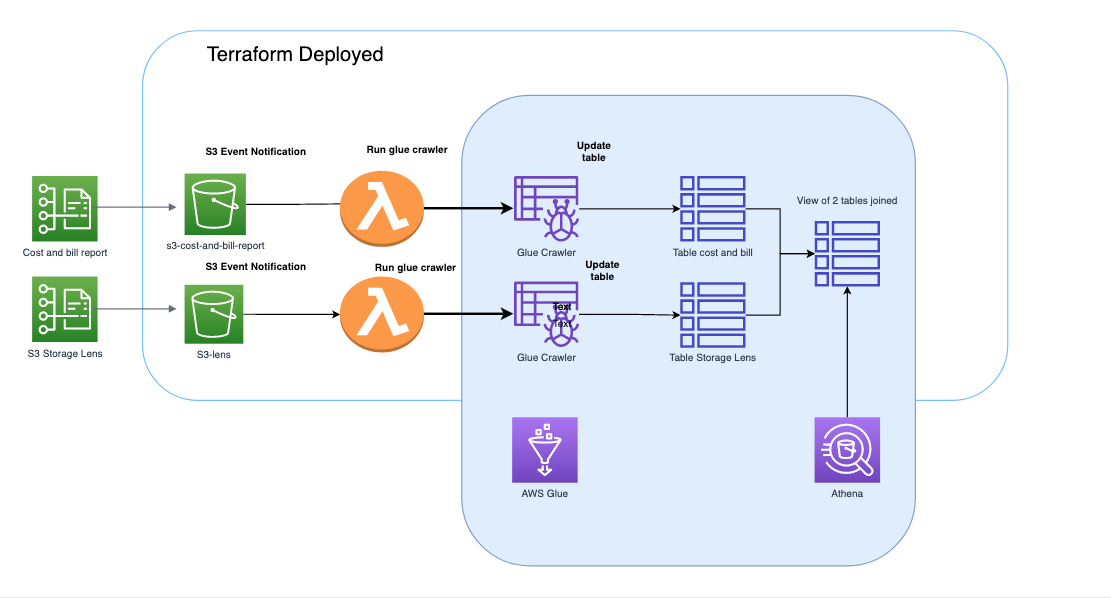
It’s possible to control Query Access and Costs from workgroup in Athena.
At the end, you will be able to query your db with Athena to have a result like that in seconds.

As it’s using SQL to make the query on S3, it will easy to make parsing or grouping and moreover using Athena and workgroup, you will be able to control who is able to make the query.
How to use the Terraform module
You can clone the module or even better using it directly from my github repository
Follow the procedure below to configure the module.
terraform {
required_version = "~>0.14.6"
required_providers {
aws = {
source = "hashicorp/aws"
version = "~> 3.27"
}
}
}
provider "aws" {
region = "eu-west-1"
}
module "aws_s3_cost_explorer" {
source = "git::https://github.com/archi-jusi/s3_cost_overview_serverless.git//terraform//modules/storage"
project = "aws-s3-cost"
environment = "staging"
namebucketcostreport = "staging-cost-bucket"
namebucketathena = "staging-cost-athena"
namebucketlens = "staging-cost-lens"
namelensdashboard = "dashboard-lens-staging"
costprefix = "cost"
costreportname = "costreport"
workgroupname = "workgroupcostathena"
databasename = "database_terraform"
organization = false
tags = {
env = "staging",
owner = "devopshandsonlab",
terraform = "true"
project = "s3_overview_cost_project"
}
}
Note:
The input variable cost prefix and costreportname will be used later to create the cost and usage report. Unhappily, this step will not be automate as Terraform has the feature only for us-east-1.
The module will deploy 34 resources as below:
aws_athena_database.dbathena
aws_athena_named_query.sqlcostview
aws_athena_named_query.sqljoinview
aws_athena_named_query.sqllensview
aws_athena_named_query.sqlselectglobalview
aws_athena_workgroup.workgroupcostathena
aws_glue_crawler.glue_crawler
aws_glue_crawler.glue_crawler-lens
aws_iam_policy.custom-policy-glue
aws_iam_policy.custom-policy-glue-lens
aws_iam_policy.policy-lambda
aws_iam_policy.policy-lambda-lens
aws_iam_role.gluerole
aws_iam_role.gluerole-lens
aws_iam_role.lambdarole
aws_iam_role.lambdarole-lens
aws_iam_role_policy_attachment.glue_role_attach_policy_custom
aws_iam_role_policy_attachment.glue_role_attach_policy_custom-lens
aws_iam_role_policy_attachment.glue_role_attach_policy_managed
aws_iam_role_policy_attachment.glue_role_attach_policy_managed-lens
aws_iam_role_policy_attachment.lambda_role_attach_policy
aws_iam_role_policy_attachment.lambda_role_attach_policy-lens
aws_lambda_function.lambdarungluefunction
aws_lambda_function.lambdarungluefunction-lens
aws_lambda_permission.allow_bucket_event_notification
aws_lambda_permission.allow_bucket_event_notification-lens
aws_s3_bucket.s3_backend["athenabucket"]
aws_s3_bucket.s3_backend["costbucket"]
aws_s3_bucket.s3_backend["lensbucket"]
aws_s3_bucket_notification.bucket_notification-lens
aws_s3_bucket_notification.bucket_notification_cost_report
aws_s3_bucket_public_access_block.blockbucket["athenabucket"]
aws_s3_bucket_public_access_block.blockbucket["costbucket"]
aws_s3_bucket_public_access_block.blockbucket["lensbucket"]
output.tf has to be set as below
output "information" {
description = "output of module"
value = module.aws_s3_cost_explorer
}
and will output :
Apply complete! Resources: 34 added, 0 changed, 0 destroyed.
information = {
"arn" = [
"arn:aws:s3:::staging-cost-athena",
"arn:aws:s3:::staging-cost-bucket",
"arn:aws:s3:::staging-cost-lens",
]
"bucket_name" = [
"staging-cost-athena",
"staging-cost-bucket",
"staging-cost-lens",
]
"currentaccount" = "314283085815"
"currentpartition" = "eu-west-1:314283085815"
"currentregion" = "eu-west-1"
"databaseforathena" = "database_terraform"
"gluecrawler" = "aws-s3-cost-staging-crawler"
"gluerole" = "aws-s3-cost-staging-role-glue"
"gluerolelens" = "aws-s3-cost-staging-role-glue-lens"
"lambdarole" = "aws-s3-cost-staging-role-lambda"
"lambdarolelens" = "aws-s3-cost-staging-role-lambda-lens"
"regionbucket" = [
"eu-west-1",
"eu-west-1",
"eu-west-1",
]
"workgroupathena" = "workgroupcostathena"
}
Once everything is deployed from the module with Terraform you will need to create a cost and usage report using the variable set in the module:
- costprefix
- costreportname
From billing,
Create a new report, use the name you defined in the module from the variable costreportname and check the box Include resource IDs
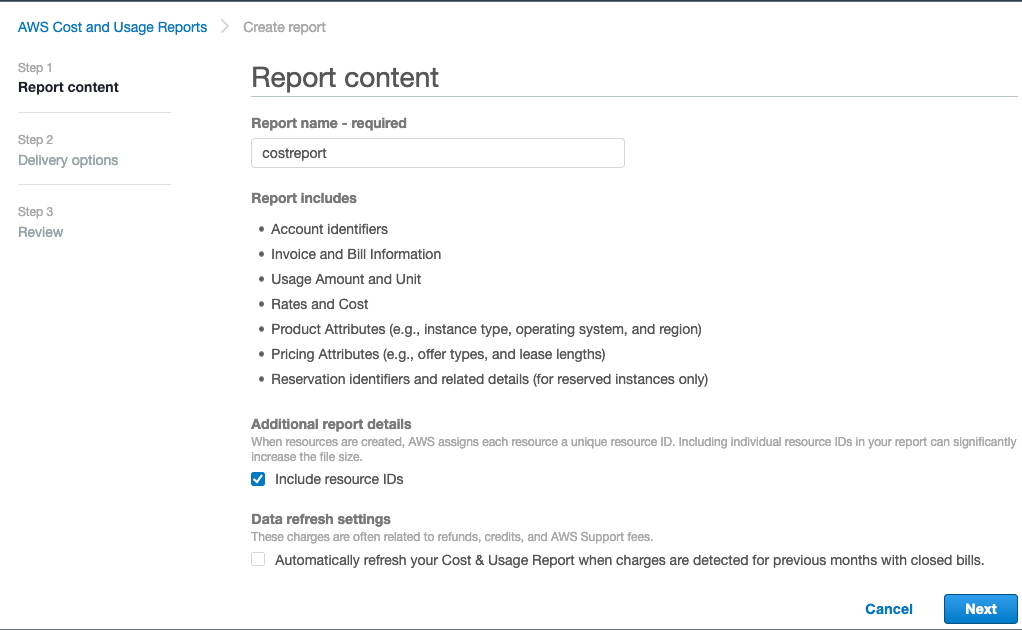
Next step, select the bucket create by Terraform defined with the variable namebucketcostreport , set the prefix defined in the variable costprefix. Select daily and Athena to use the Parquet compression.

NOTE: Once the report will be create, you will need to wait until 24h before getting the first report.
Then, for Storage Lens, as it’s a quite new service, it’s not possible at all to deploy from Terraform or even Cloudformation, or aws CLI and we will need to wait until 48h that the report is active.
Storage Lens will give us these information:
Total storage
Object count
Current version bytes
Current version object count
Noncurrent version bytes
Noncurrent version object count
Delete marker object count
Encrypted bytes
Encrypted object count
Replicated bytes
Replicated object count
Object lock bytes
Object lock object count
Incomplete MPU bytes
Incomplete MPU object count
To enable Storage Lens, Master account of your organization has to be used.
By default, this terraform module is done for an organization but if you want to have this features just for the account you are using with Terraform, you can change the variable organization to false (bool).
module "aws_s3_cost_explorer" {
source = "..."
organization = false
...
}
Let’s enable this amazing feature
You will need to use your master account to enable this feature for your organization.
First choose a name, the name has to be what you define in the variable of the module namelensdashboard and the bucket
module "aws_s3_cost_explorer" {
source = "..."
namelensdashboard = "dashboard-lens-staging"
namebucketlens = "staging-cost-lens"
...
}
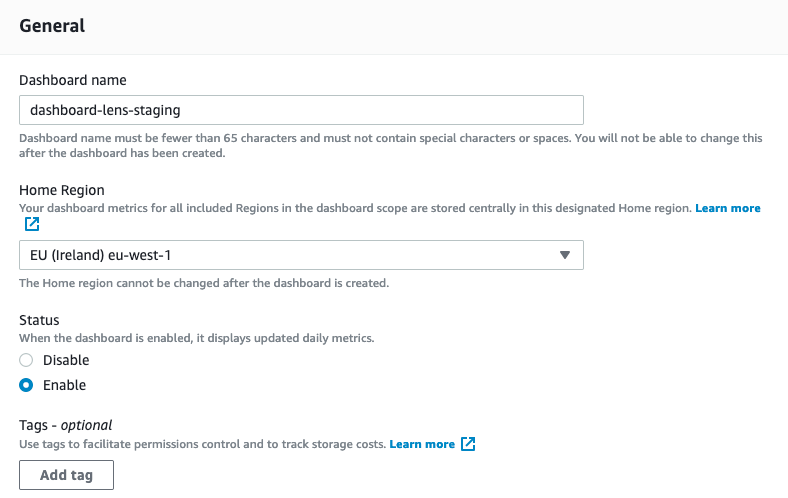
For the Home region, choose the same region you were using with terraform.
Then, configure as below:
Select Include all accounts in your organization or Limit the scope to your signed-in account if you defined the variable organization to false.
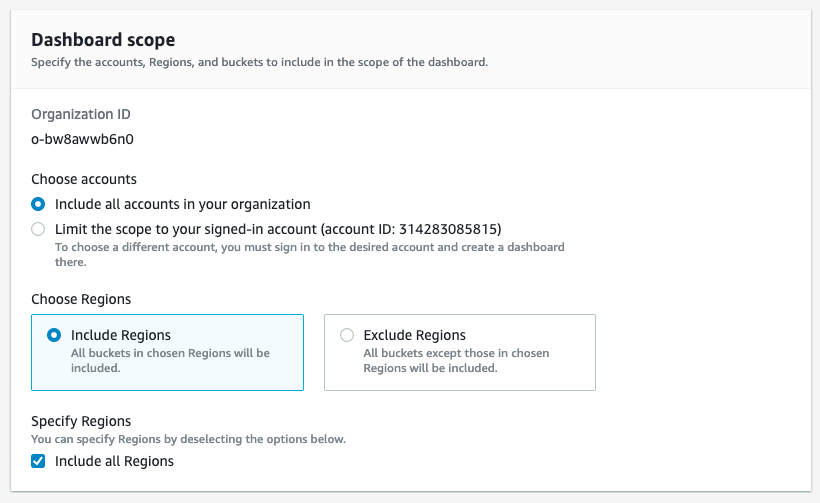
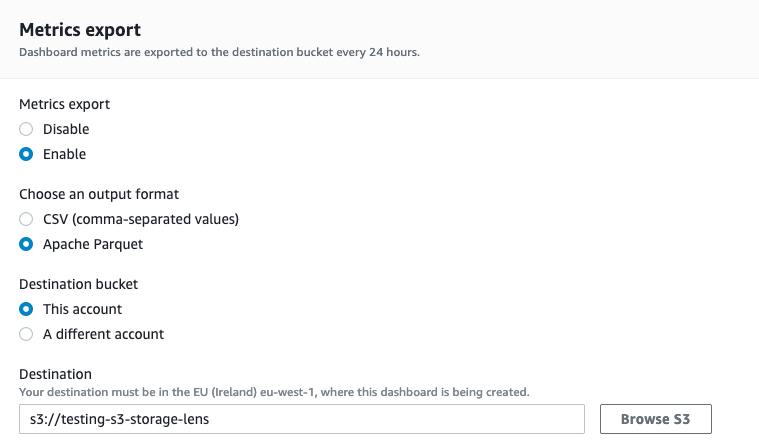
For the storage, select the bucket defined from variable namebucketlens.
Note : Select output format as Apache Parquet.
Storage Lens should be enable in the next 48h ! 😄
Once, StorageLens and cost report are active, S3 event notification will notify Lambda which will run the glue crawler to update the Glue Data Catalog.
When everything is settle, you will be able from Athena to query the information about your bucket. Notice that you need to choose the correct workgroup and database to make your queries.
You will find few saved queries in the workgroup that you need to execute in order to create view and join table to make your queries running faster and easier.
The Saved queries will use automatically the correct DB and table.
Moreover, you can couple with quicksight for visual analytic and Business Intelligence.
The tradeoff is that it will not give you all the information needed but each solution has always tradeoff and the priority was to get information about the cost.

